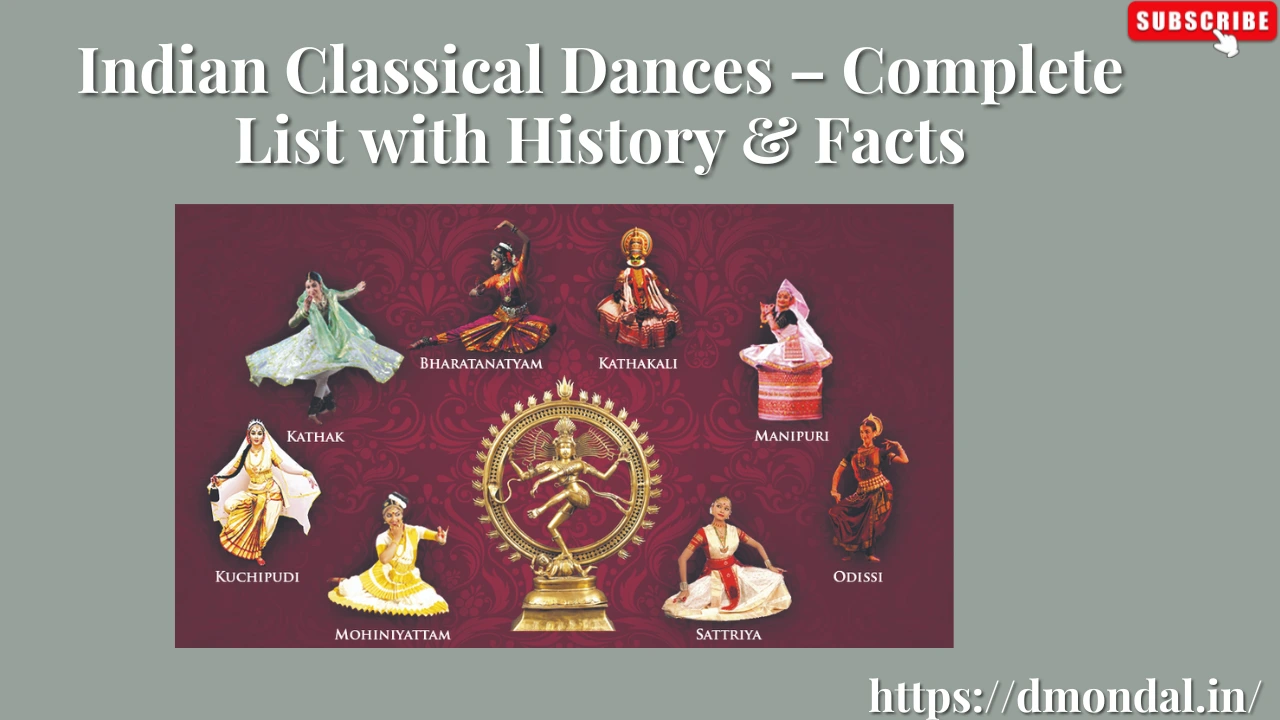Indian Classical Dances – Complete List with History & Facts
India is a land of rich culture and tradition, and its classical dances reflect the country’s heritage, spirituality, and artistic excellence. These dances are not only a form of entertainment but also a medium of storytelling, expression, and devotion.
Recognized for their ancient origins, intricate movements, and traditional music, Indian classical dances are performed across the country and are an integral part of Indian culture.
In this article, we provide a complete list of Indian classical dances, their origin, style, and key facts.
✅ 1. Bharatanatyam – Tamil Nadu
- Origin: Tamil Nadu, Southern India
- Style: Graceful footwork, intricate hand gestures (mudras), and expressive storytelling
- Facts: One of the oldest classical dances of India, performed to depict Hindu mythology and devotion.
✅ 2. Kathak – Uttar Pradesh
- Origin: North India (Lucknow and Jaipur)
- Style: Spins (chakkars), fast footwork, storytelling with facial expressions
- Facts: Kathak evolved in royal courts and temples; it narrates stories of Krishna and other legends.
✅ 3. Kathakali – Kerala
- Origin: Kerala, Southern India
- Style: Elaborate costumes, face painting, dramatic expressions, and storytelling through gestures
- Facts: Traditionally performed at temples; depicts Hindu epics like Ramayana and Mahabharata.
✅ 4. Kuchipudi – Andhra Pradesh
- Origin: Andhra Pradesh
- Style: Combines dance, drama, and singing; involves graceful movements and intricate footwork
- Facts: Kuchipudi often portrays devotional stories and mythological characters.
✅ 5. Odissi – Odisha
- Origin: Odisha
- Style: Sculptural poses, lyrical movements, expressions, and tribhangi posture (three bends of the body)
- Facts: Odissi is performed in temples as an offering to Lord Jagannath.
✅ 6. Manipuri – Manipur
- Origin: Manipur, Northeast India
- Style: Soft, graceful, and fluid movements; focuses on devotional themes
- Facts: Often performed during Vaishnavite festivals, portraying stories of Radha-Krishna.
✅ 7. Mohiniyattam – Kerala
- Origin: Kerala, Southern India
- Style: Graceful, swaying movements resembling a female enchantress
- Facts: Known as the dance of the enchantress, performed to narrate stories from Hindu epics.
✅ 8. Sattriya – Assam
- Origin: Assam, Northeast India
- Style: Combines dance, drama, and music; devotional storytelling
- Facts: Introduced by Vaishnavite saint Srimanta Sankardev, performed in monasteries (Sattras).
📊 Summary Table – Indian Classical Dances
| Dance Form | State/Region | Key Feature | Devotional/Storytelling Focus |
|---|---|---|---|
| Bharatanatyam | Tamil Nadu | Footwork, Mudras | Hindu Mythology |
| Kathak | Uttar Pradesh | Spins, Expressions | Krishna Legends |
| Kathakali | Kerala | Costumes, Facial Makeup | Ramayana, Mahabharata |
| Kuchipudi | Andhra Pradesh | Drama & Dance | Mythological Stories |
| Odissi | Odisha | Sculptural Poses | Lord Jagannath Devotion |
| Manipuri | Manipur | Graceful, Fluid Movements | Radha-Krishna Stories |
| Mohiniyattam | Kerala | Gentle, Enchanting Moves | Devotional Epics |
| Sattriya | Assam | Monastic Devotional Dance | Vaishnavism |
🌟 Importance of Indian Classical Dances
- Preserves cultural heritage and traditions of India.
- Enhances discipline, coordination, and artistic expression.
- Used to teach mythology, devotion, and moral lessons.
- Boosts tourism through festivals and performances.
- Inspires modern dance forms globally.
🌏 Final Thoughts
Indian classical dances are a living heritage that reflect the diversity and richness of India’s culture. From the intricate mudras of Bharatanatyam to the flowing grace of Manipuri, each dance form tells a unique story, keeping ancient traditions alive.
Whether you are a student, dancer, or traveler, learning about Indian classical dances is an enriching experience that connects you to the heart of Indian culture.
Read More: Click here
